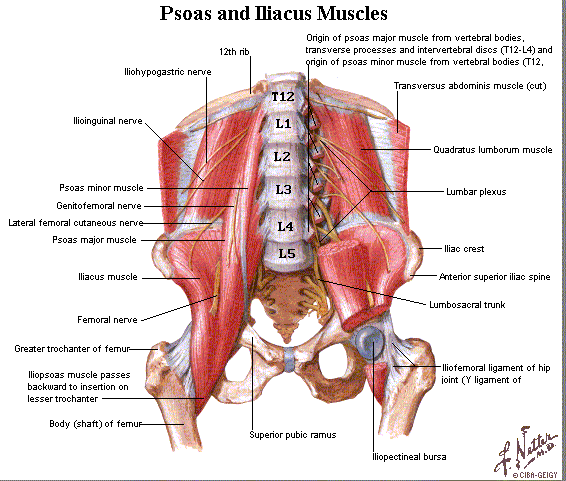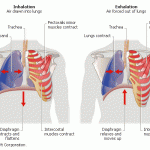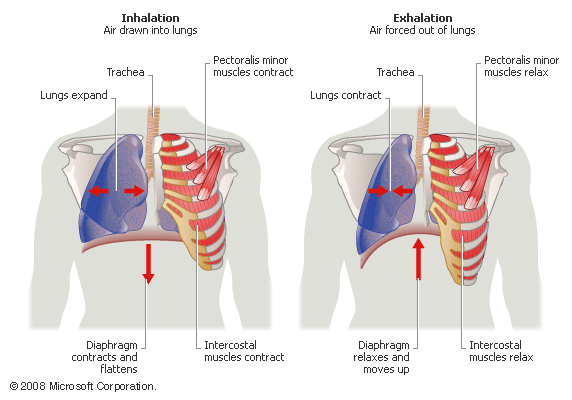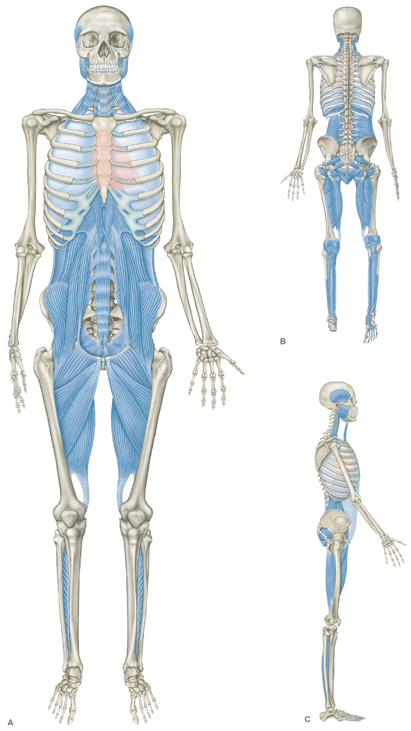Take a Deep Breath – James Crader
When a new client walks into my studio, after taking an eval and having them walk around for me to observe movement patterns, the next order of business is to watch them breathe. I’m looking to see how their body processes the endeavor. Are they chest breathers / belly breathers / through the nose or mouth / is there a sound associated / does it look comfortable / have they learned “how to breath” somewhere and are stuck in that pattern? Likewise I start all my classes this way, and the majority of my private sessions too. Not only is it a good centering exercise for my clients, but it lets me know where they are physically and somatically today – is my class filled with tight backs and anxious breaths, or is the class fluidly breathing and calm?
Breathing is one of those magical involuntary bodily functions that we have quite a bit of voluntary control over. Granted your body will breathe regardless of if/how you want it to (if the brainstem registers too much carbon dioxide in the blood it stimulates an inhalation reflex), you still have many choices in how to explore that breath. Let’s start with the basics. The thoracic diaphragm is the main muscle involved in facilitating respiration. When it contracts, and descends into the abdominal cavity (approx one half inch), we inhale. When this diaphragm relaxes, it ascends back into the chest cavity and we exhale. After the heart, the diaphragm is the most utilized muscle in the body. Luckily it’s designed for longevity, as its natural functional rhythm has a longer resting rate than it has working rate. Meaning ideally the diaphragm is relaxed more than it’s contracted, and our exhales are about 1.5x as long as our inhales. Uh! Oh! What about the clients we all have that, even while resting, take in labored inhales, barely exhale, and breathe rapidly? How healthy is that diaphragm? Likewise, the spine and rib cage should lengthen longitudinally as we inhale, allowing the shoulder girdle and pelvis to expand. Double UH! OH! What about all those clients whose shoulders tense and hike as they breathe, and they (not so) ironically come in symptomizing with neck and/or shoulder issues? Or those with no posterior rib breath that have SI Joint problems and/or plantar fascial pain? Not to mention the client whose sternum never budges in either an inhale nor exhale – bet they suffer from headaches!
Let’s go a level deeper. The more we know about fascia, the more we understand that our body is globally connected. We are contiguous (one of my favorite words). There is no difference in muscular health / pelvic health / gut and visceral health / cardiac health / etc.. While I don’t completely subscribe to the Thomas Myers’ model of fascia, it has created a succinct vocabulary for all of us to intelligently discuss what we might be observing when discussing fascia and movement. So, let’s discuss Myers’ Deep Front Line (DFL). The DFL runs from the bottom of both feet, through the deep calves, inner legs, inner pelvis and sacrum, up the anterior side of the lumbar, into the lower thoracic spine, and joins into the diaphragm, and pericardium (sac) of the heart, along with some sternal rib tissue, and up through the scalenes and other throat musculature, the tongue, and even into some of the facial muscles.
Deep Front Line
While that soft tissue certainly has relationship/s with other structures, there is a strong connection between all of the aforementioned landmarks. The DFL is responsible for lifting our inner arches (diaphragms of the body), stabilizing each segment of the leg, supporting the lumbar spine from the front, stabilizing the chest, and balancing the neck and head on top of the spine. So, if breath is so important to our body that it will automatically happen regardless of volition, and our thoracic diaphragm is the main muscle of the breath, then it must also be important to the well-being of the DFL, its associates, and their functions.
Somewhere along the line we’ve mixed up breathing deeply for breathing fully. The difference isn’t semantics. Breathing fully is just that. It’s taking expansive breathes with the intention of fully filling the lungs to capacity. Often this breath is a wide breath that ends up tightening the shoulder girdle. A deep breath is directional. Breathe from deep within the body (and not strictly to full capacity). The difference may be seen analogously as breathing from deep within a canyon instead of across the expanse of a canyon. I hesitate to name it deep diaphragmatic breathing, as many people have learned a version of this in their yoga class, and that version isn’t always exactly correct. In a deep breath there is still some tensile rigidity to the abdominal complex, and the breath is still experienced throughout the ribcage … it’s not necessarily a soft belly breath (although that breath is a good visceral and illiopsoas massage). Full breaths often become militant with the chest puffing out, the shoulders tightening, and the chin jutting forward (not only decreasing mobility, but also heart health, as the pericardium becomes adhered to the sternum and the neck strain reduces the necessary pressure in the upper lobes of the heart). The ribcage begins to act as a tubular unit rather than freely moving segmental parts, and fascial continuity is disordered. This disrupts the breath’s ability to massage each spinal disc, creates imbalance in the TVA, and loads the T12/L1 junction (or L4/L5 junction alternately), and the low cervical vertebrae. I’ve seen so many clients interpret Pilates breath as this militant breath, and are then left struggling to organize their forward head, tight back, weak TVA, and overworked deep hip flexors in opposition of the breath they’re either being cued or self-cueing that is not only eliciting but strengthening these faults. Regardless of whether tight muscle tissue is creating a specific breath pattern, or if the breath creates the tight musculature, the amazing thing about relationships in a contiguous system is that if one aspect is altered then a movement intervention takes place everywhere.
Addressing a client’s breathing pattern, and diaphragm suppleness, is not only critical in assessing trunk strength and mobility, but also the function of their limbs. The twelfth thoracic vertebra (and its associated ribs) and the first lumbar vertebra is a major intersection in the body. The Psoas muscles attach here, The trapezius muscles attach here, the thoracolumbar fascia attaches here, this area is associated with the kidneys and adrenal glands, and the solar plexus, and the diaphragm is also attached here through its arcuate ligaments. If this junction becomes untuned with the continuum of the spine, quite a bit is affected, including the health of our shoulder and pelvic girdles.
 An argument can be made that humans have what may be considered “brachiation shoulders.” Brachiators are a class of primates that tend to swing from branch to branch by their hands. Their shoulders exhibit a larger amount of shoulder musculature below their shoulder joint, rather than above, to aid in this acrobatic suspension. Although we’ve evolved into bipedal walking animals (praise evolution), humans have much more shoulder muscle below or lateral to the joint (rotators, rhomboids, serratus, trapezius, and latissimi to name a few) than above. This topic is a whole ‘nother blog article, but it’s important to the point. Our largest arm muscles, the trapezius and the latissimi (the later by way of the thoracolumbar fascia) are directly influenced by the T12 vertebra. Scapular function is also coincident with the health of these muscles, and as we all know our arms are only as healthy as our shoulder blades are mobile. Additionally many somatic practitioners consider the arms as being governed by the head and neck, rather than the spine and ribs. The head balances atop the spine, and numerous muscles suspend from this cranial anchor (scalenes, splenius capitis, SCM, trapezius, …) and attach to the clavicles and scapulae, which in turn regulate the health of our arm function. Since the DFL connects these landmarks, and by virtue of its function helps to balance the head, and since the diaphragm is integral to the DFL, a healthy diaphragm is essential to proper arm function from whichever direction you look for support, superior or inferior.
An argument can be made that humans have what may be considered “brachiation shoulders.” Brachiators are a class of primates that tend to swing from branch to branch by their hands. Their shoulders exhibit a larger amount of shoulder musculature below their shoulder joint, rather than above, to aid in this acrobatic suspension. Although we’ve evolved into bipedal walking animals (praise evolution), humans have much more shoulder muscle below or lateral to the joint (rotators, rhomboids, serratus, trapezius, and latissimi to name a few) than above. This topic is a whole ‘nother blog article, but it’s important to the point. Our largest arm muscles, the trapezius and the latissimi (the later by way of the thoracolumbar fascia) are directly influenced by the T12 vertebra. Scapular function is also coincident with the health of these muscles, and as we all know our arms are only as healthy as our shoulder blades are mobile. Additionally many somatic practitioners consider the arms as being governed by the head and neck, rather than the spine and ribs. The head balances atop the spine, and numerous muscles suspend from this cranial anchor (scalenes, splenius capitis, SCM, trapezius, …) and attach to the clavicles and scapulae, which in turn regulate the health of our arm function. Since the DFL connects these landmarks, and by virtue of its function helps to balance the head, and since the diaphragm is integral to the DFL, a healthy diaphragm is essential to proper arm function from whichever direction you look for support, superior or inferior.
The arcuate ligaments that form the rim of the diaphragm also interact with the quadratus lumborum muscles, and the illiopsoas. While the crura of the diaphragm, the long fibers that pull the diaphragm down during inspiration, attach to L1 – L4 vertebrae by way of the anterior longitudinal ligament that runs down the front of the spine. The diaphragm is therefor directly associated with the posture and movement of the pelvis and legs, and vice versa. An absence of low posterior rib breath is often associated with tight back muscles and an anteriorly rotated pelvis. A posteriorly rotated pelvis often exhibits lengthened back muscles and an absence of anterior diaphragmatic and rib movement during inspiration. Again, being a contiguous relationship which of these aspects are more important: the breath, the posture, or the soft tissue? As Pilates teachers we’re all too aware of how, even a moderately skewed, pelvic position can greatly affect the integrity of leg movement. Furthermore the diaphragm is fascially connected with the pelvis, sacrum, and lower extremities through the DFL (levator ani / adductors / popliteal / deep calf muscles / and into the soles of the feet and toes). It’s all one big system with the piston of breath powering us forward and onward.
This brings us to a treasured question: So what? My thought is, keep teaching the breath work you’re most comfortable teaching and layer in some of this (possibly) new info. If percussive breathing, lateral breathing, mouth or nose breathing is working for you … can it be accomplished a little more deeply? Play around with breath. Do you have access to breathing into your kidneys / chest / belly / through your nose (with one nostril pinched closed … or not) / how about with sound? Creating the sound “Ch” (as in cheese) while exhaling may help you access some lower abdominal strength. While the sound “Hssss” (like a snake, or air leaking from a tire) may help you decompress the lungs more fully. For me, sound is very important in movement. I can always tell when a client starts to breathe more deeply by the sound of their body – not solely the sound of the breath, but also the sound of visceral movement (the guts love a good deep breathing session, and will often begin to gurgle). Encourage that client to yawn when they feel the need (pandiculation!!). Is there ever longitudinal movement happening in an inhale … for your client … for you as you move? Essentially are you lengthening by means of an inhale? Or is your breath compressive to your spinal discs? Unilaterally, as with scoliosis? Once you begin to understand the rules of how breathing works, then playing with breath is like painting. With understanding you can highlight, minimize, or shift anything you want, but if you don’t understand the primary colors of breath, then maybe hold off on shading the picture. As well, avoid becoming dogmatic about breath. The cardinal rule of “just breathe” still applies. This is all just something else for you to consider when you’re looking at your client and what you’re seeing just doesn’t seem quite right, and possibly a little shallow.
James Crader is a Movement Coach specializing in Pilates and John F. Barnes Myofascial Release Therapy, a CoreAlign Faculty Member, and owner of Evolved Body in Sacramento, CA. Growing up he’d have never thought anything fitness would be his calling … his position in kickball was “being picked last” and he literally scored points for the opposing basketball team (maybe more than once). What he was good at though was experiencing. He loved to listen, learn, play with the shapes he could make while rolling around on the ground, he even practiced writing with his toes (just in case). All that made for a weird kid, but an innovative movement teacher. James began his Pilates training with Balanced Body, but has gone on to study with numerous teachers from many lineages of Pilates and beyond (an overspending problem when it comes to workshops and courses … for sure). He’s finally doing something with that Interpersonal Communications degree (that took “more than it should have” years to earn) and is now writing articles, creating video content, and teaching more workshops. You can find his blog at thePilatesDude (now in beta format … because ain’t nobody got time to make things pretty).



